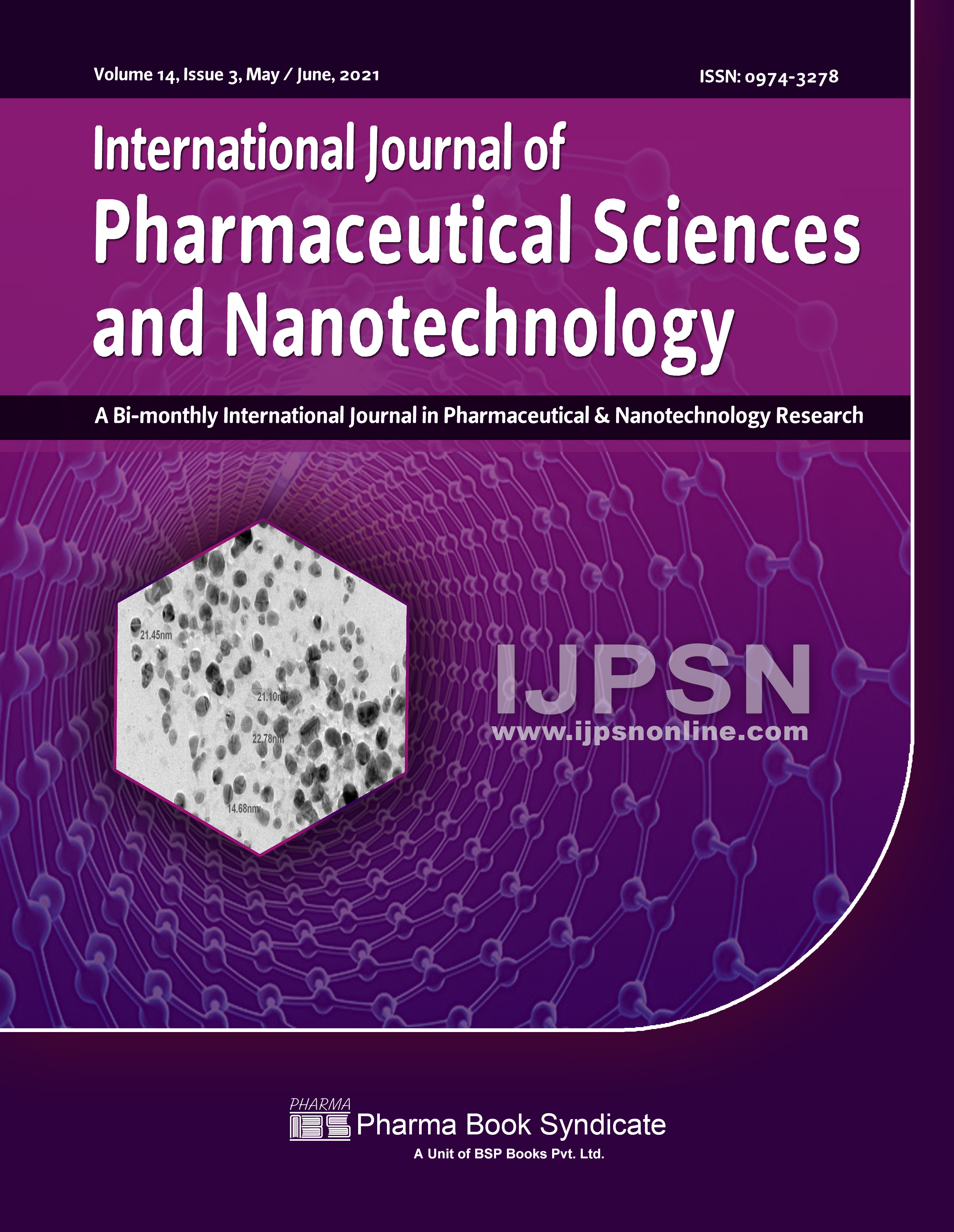Formulation and Evaluation of Benidipine Nano-suspension by Precipitation Method using Central Composite Design
DOI:
https://doi.org/10.37285/ijpsn.2021.14.3.6Abstract
In the interest of administration of dosage form oral route is most desirable and preferred method. Poor solubility and slow dissolution rate major challenges in upcoming and existing therapeutically active compound. Water insoluble drug indicate insufficient bioavailability as well dissolution resulting in fluctuating plasma level. Benidipine (BND) is Biopharmaceutical Classification System Class-II drug having low solubility and high permeability, antihypertensive drug has lower bioavailability. The purpose of the present study was to improve solubility as well dissolution profile of Benidipine HCL. BND nanosuspension was formulated using precipitation technique. Various polymers were evaluated viz. HPMC E15, Tween 20, PVP K30 in preliminary trial to stabilized nanosuspension but PVP K30 was selected among them. The solubility of BND was carried out using different solvents like Ethanol, Acetonitrile; Acetone. Ethanol was used as a preferred solvent as BND shows high solubility in it. The effect of different important process parameters e.g. selection of polymer concentration X1(10 mg), solvent concentration X2 (0.2 ml) were investigated by Central Composite factorial design to accomplish desired particle size and rate of dissolution. Stirring speed and time of stirring was kept constant as 1000 rpm and 2h respectively. To achieve optimized batch, 9 formulations (F1-F9) were prepared. The optimized batch had 237 nm particle size Y1, and showed in-vitro dissolution Y2 98±0.72 % in 30 mins related to pure BND (58±0.25%) and zeta potential was -15.3. None of interaction between drug and polymer was confirmed by Differential scanning calorimetry (DSC) and FT-IR analysis. The obtained results showed that issues related particle size (nm) and rate of dissolution of BND has been solved when nanosuspension can be prepared by precipitation method by considering optimized parameter due to formation of nanosized particles
Downloads
Metrics
Keywords:
Benidipine, Biopharmaceutical Classification System, Bioavailability, Particle size, Central Composite Design, precipitation technique, NanosuspensionDownloads
Published
How to Cite
Issue
Section
References
Billon, A., Bataille, B., Cassanas, G. and Jacob, M., (2000). Development of spray-dried acetaminophen microparticles using experimental designs. Int. J. Pharm. 203, 159–168.
C Jacobs; O Kayser and R.H Muller; (2000), Nanosuspensions as a new approach for the formulation for the poorly soluble drug tarazepide Int. J. Pharma 196,161–164.
Dollo, G., Le Corre, P., Guerin, A., Chevanne, F., Burgot, J.L. and Leverge, R., (2004). Spray-dried redispersible oil-in-water emulsion to improve oral bioavailability of poorly soluble drugs. Eur. J. Pharm. Biopharm. 19, 273–280.
Hu, J., Rogers, T.L., Brown, J.N., Young, T.J., Johnston, K.P. and Williams, R.O., (2002). Improvement of dissolution rates of poorly water soluble APIs using the novel spray freezing into liquid technology. Pharm. Res. 19, 1278–1284.
Junghanns JUAH and Müller RH. (2008). Nanocrystal technology, drug delivery and clinical applications. Int J. Nanomedicine; 3: 295-309.
Jung, J. and Perrut, M., (2001). Particle design using supercritical fluids: literature and patent survey. J. Super Fluids 20, 179–219.
Merisko-Liversidge, E., (2002). Nanocrystals: Resolving Pharma-ceutical Formulation Issues Associated with Poorly Water-soluble Compounds in Particles. Marcel Dekker, Orlando.
Merisko-Liversidge E, Liversidge GG and Cooper ER, (2003) Nanosizing: a formulation approach for poorly-water-soluble compounds. Eur J. of Pharm Sci.; 18 (2): 113-120.
Mittal P, Singh P, Verma A, Khinchi MP, Agarwal D, Gupta MK and Sigh SP (2013). Nanosuspension: Newer approach for drug delivery system. Asian J Pharm Research and Devp 1: 2-12.
Moretti, M.D.L., Gavini, E., Juliano, C., Pirisino, G. and Giunchedi, P., (2001). Spray-dried microspheres coantaining ketoprofen formulated into capsules and tablets. J. Microencapsul. 18, 111–121.
Muhrer, G., Meier, U., Fusaro, F., Albano, S. and Mazzotti, M., (2006). Use of compressed gas precipitation to enhance the dissolution behavior of a poorly water soluble drug: generation of drug microparticles and drug-polymer dispersions. Int. J. Pharm. 308, 69–83.
Peters K, Leitzke S, Diederichs JE, Borner K, Hahn H, Müller RH and Ehlers S (2000). Preparation of a clofazimine nanosuspension for intravenous use and evaluation of its therapeutic efficacy in murine Mycobacterium avium infection. J Antimicrobial Chemotherapy. 45(1):77-83.
Rasenack, N., Hartenhauer, H. and Muller, B.W., (2003). Microcrystals for dissolution rate enhancement of poorly water-soluble drugs. Int. J. Pharm. 254, 137–145.
Rogers, T.L., Hu, J., Yu, Z., Johnston, K.P. and Williams, R.O., (2002). A novel particle engineering technology: spray-freezing into liquid. Int. J. Pharm. 242, 93–100.
Rogers, T.L., Overhoff, K.A., Shah, P., Santiago, P., Yacaman, M.J., Johnson, K.P. and William III, R.O., (2003). Micronized powders of a poorly water soluble drug produced by a spray-feezing into liquid-emulsion process. Eur. J. Pharm. Biopharm. 55, 161–172.
Satya S. Sahoo, Chandu Rao and Ashis Mehta (2015). Formulation Development and Optimization of Nanosuspension of Simvastatin for Improved Solubility by Nanomilling. J. Pharm SciTech; 5 (2), 78-86.
Shariati, A. and Peters, C.J., (2003). Recent developments in particle design using supercritical fluids. Curr. Opin. Solid State Mater. Sci. 7, 371–383.
S. S. Shelake and S. V. Patil, S. (2018). Patil Formulation and Evaluation of Fenofibrate-loaded Nanoparticles by Precipitation Method; Indian J Pharm Sci; 80(3): 420-427.
S Verma; R Gokhale and D Burgessa (2009). A comparative study of top-down and bottom-up approaches; Int J Pharma, 380: 216–222.
Wang YC, Zhang DR, Liu ZP, Liu GP, Duan CX, Jia LJ, Feng FF, Zhang XY, Shi YQ and Zhang Q (2010). In vitro and in vivo evaluation of silybin nanosuspensions for oral and intravenous delivery. Nanotechnology 21: 155104.
Yalkowsky, S.H. (Ed.), (1981). Techniques of Solubilization of Drugs. Marcel Dekker, NY Int. J phar sci. 1984; 73(2) ,288-288.
Yadav GV and Singh SR (2012). “A review article on Nanosuspension-a promising drug delivery system Pharmacophore”, An Int. J. res, , 3(5),217-43.
Y.Kozo, K Nagashima, and M. Hiroyuki. (2006). Pharmacological, pharmacokinetic, and clinical properties of benidipine hydrochloride, a novel, long-acting calcium channel blocker. J Pharmac Sci: 100; 243 – 261.






